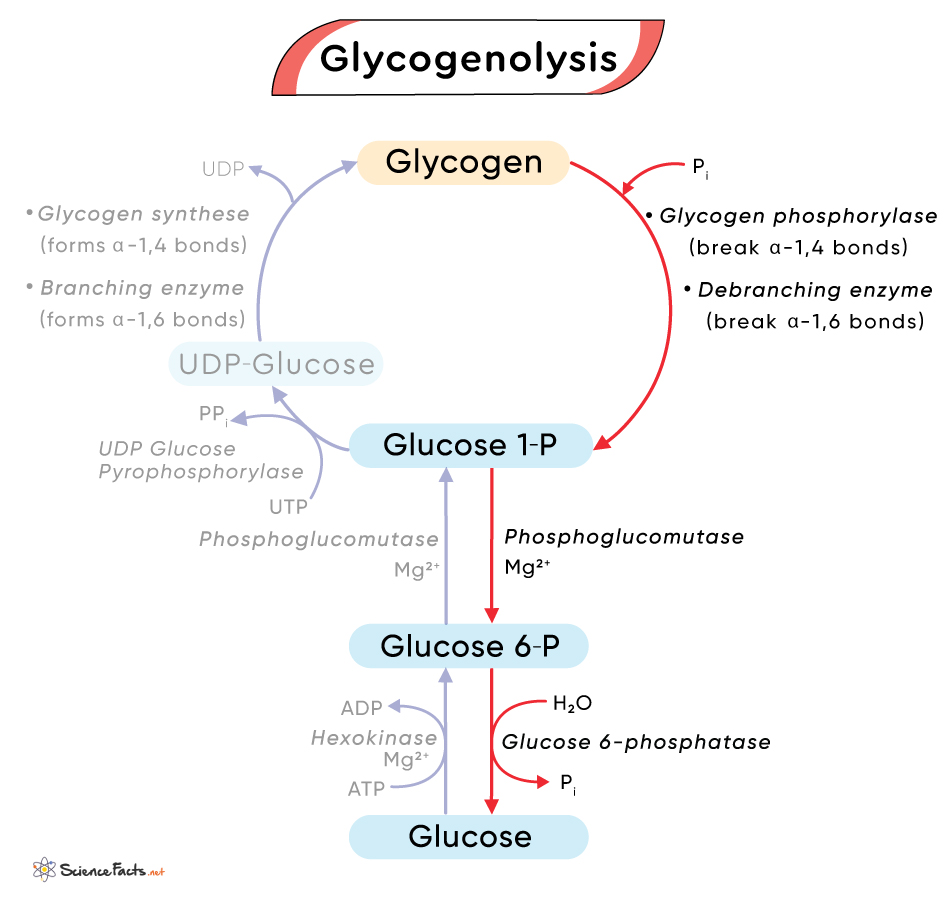Glycogenolysis
Glycogen is the storage form of carbohydrates in our bodies. It comprises a series of long-chain glucose molecules joined by alpha -1,4- glycosidic bonds arranged linearly and linked by alpha-1,6 bonds at the branch point.
Glycogenolysis is the biochemical pathway of the breakdown of glycogen into a simple sugar, like glucose. It occurs when our body needs glucose for instant energy. This process is stopped when excess glucose is in the bloodstream.
In this biochemical pathway, glycogen breaks down into glucose-1-phosphate and glucose. The opposite of glycogenolysis is glycogenesis, which is glycogen formation from glucose molecules.
Where Does Glycogenolysis Occur
Glycogenolysis occurs in the cytoplasm or lysosomes of cells in the liver, muscles, and adipose tissue.
In the liver cells (hepatocytes), when blood glucose levels are low during starvation, hormones activate enzymes that stimulate the breakdown of glycogen into glucose released into the bloodstream.
In the muscle cells (myocytes), it is more of an emergency stress response. However, unlike in the liver, glycogenolysis in myocytes does not cause glucose to infiltrate the bloodstream. It stays in the myocytes for further use.
Pathway of Glycogenolysis
Glycogenolysis occurs when our body needs energy in the form of glucose. It is activated by the hormones epinephrine and glucagon. Epinephrine, or adrenaline, is excreted during the fight or flight response. In contrast, glycogen is released from the pancreas during periods of low blood sugar.
Steps
Glycogenolysis involves three steps:
Step 1: Breakdown of Glycogen to Glucose-1-Phosphate
The activity of adenyl cyclase and cAMP activity triggers glycogenolysis in muscles. The binding of cAMP activates phosphorylase kinase. Then, phosphorylase b is changed to phosphorylase a, which catalyzes glycogen degradation.
In the cytosol, the breakdown of glycogen starts with glycogen converted to glucose-1-phosphate by the cytosolic enzyme glycogen phosphorylase.
In this step, the enzyme using inorganic phosphate breaks the alpha -1,4- glycosidic bond, which holds glucose molecules together.
Glycogen(n residues) + Pi ⇌ Glycogen(n-1 residues) + Glucose-1-phosphate
In the lysosome, the enzyme acid α-glucosidase uses an autophagy-dependent mechanism to break down lysosomal glycogen. It acts as an instant source of energy during the newborn stage.
Step 2: Rearrangement of Glucose-1-Phosphate to Glucose-6-Phosphate
Next, glucose-1-phosphate formed in the first step is rearranged to form glucose-6-phosphate by the enzyme phosphoglucomutase. The glucose-6-phosphate is used in glycolysis.
Step 3: Rearrangement of Glucose-6-Phosphate to Glucose
This step is catalyzed by the enzyme glucose-6-phosphatase. It forms unbound glucose as the end product that can enter the bloodstream.
Step 1 repeats until a branch point reaches four glucose residues away. The enzyme can only cleave until four units from the branch point. When it happens, the debranching enzyme transfers one of the branches to another chain, creating a new alpha-1,4 bond leaving one glucose unit that is later hydrolyzed by alpha-1,6-glucosidase to produce free glucose.
The entire pathway of glycogenolysis is represented as:
Glycogen → Glucose−1−Phosphate → Glucose−6−Phosphate → Glucose
Regulation
Thus the two regulating enzymes in the pathway are phosphorylase kinase and glycogen phosphorylase. Both enzymes are activated by phosphorylation.
Functions of Glycogenolysis
Glycogen is a form of energy storage in animals similar to starch in plants. Thus glycogenolysis is one of the primary sources of glycogen utilization and a source of energy in the absence of food in our digestive system.
Glycogenolysis plays an essential role in the fight-or-flight response and in regulating glucose levels in the blood. In myocytes, glycogen degradation provides an instant source of glucose-6-phosphate for glycolysis to provide energy for muscle contraction.
In hepatocytes, glycogen breakdown releases glucose into the bloodstream for uptake by other cells, which are utilized for various metabolic processes.
Abnormality in glycogenolysis can cause glycogen storage diseases such as Von Gierke, Pompe, Cori, and McArdle.
Compare and Contrast Glycogenolysis with Gluconeogenesis, Glycogenesis, and Glycolysis
Glycogenolysis is the breakdown of glycogen in the liver when blood glucose levels drop. It occurs in the liver, muscles, and adipose tissue.
In contrast:
- Gluconeogenesis is the synthesizes of glucose from non-carbohydrate sources like lactic acid, glycerol, and amino acids. It occurs in the liver and kidneys.
- Glycogenesis is the process of storing excess glucose for use by the body at a later time.
- Glycolysis breaks down a glucose molecule into pyruvate, ATP, and NADH.
-
References
Article was last reviewed on Thursday, June 8, 2023





ur enzyemss are wrong in the pictrue
We have made the necessary corrections.